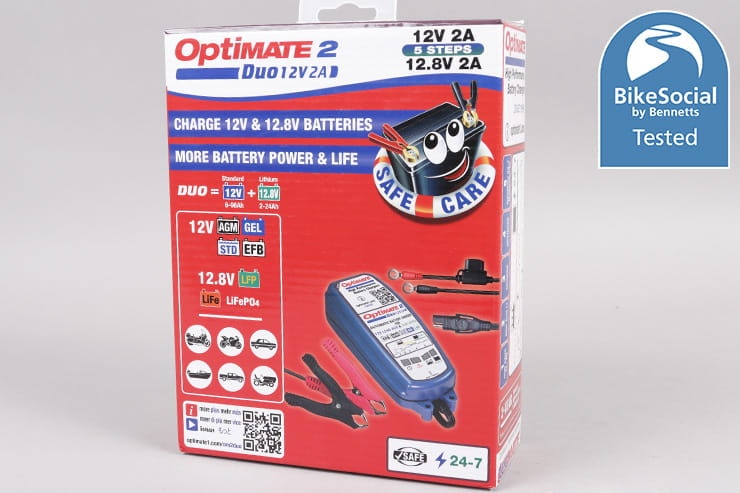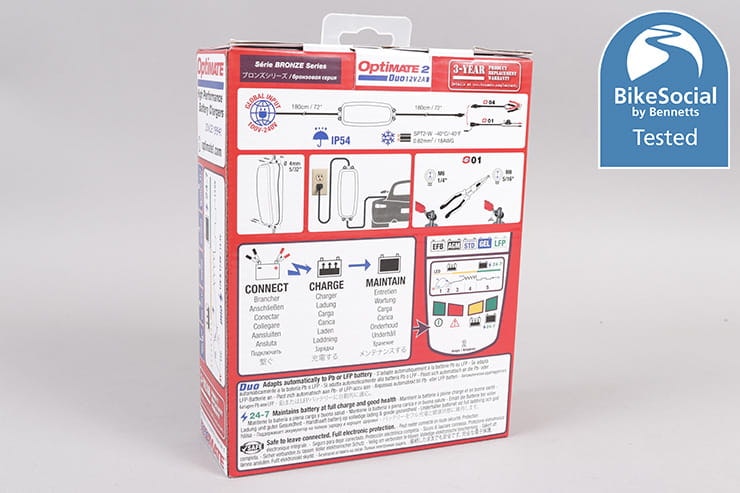Tested: Optimate 2 Duo and Optimate Monitor Review
By Stephen Lamb
Production Manager
25.10.2022
Date reviewed: October 2022 | Tested by: Stephen Lamb | Price: £71.99 + £22.99 | Optimate 2 DUO and Optimate Monitor (O-124)
We've all been there – ready to head out on your bike, you thumb the starter only to be greeted by the starter relay chattering away, or worse, nothing at all. The battery is dead! Keeping your bike fully charged and ready for action should be a simple task, but what if you have more than one bike to maintain? Should you splash out on a charger for each bike (sockets allowing) or is there a simpler way?
Optimate may have come up with the solution in the form of the Optimate Monitor which, when used in conjunction with their range of chargers (I'm testing the Optimate 2 Duo here), gives you all the information you need to maintain your bikes in perfect fighting fitness.
Armed with the charger and monitor, I headed off to my own garage containing my much-underused Ducati Scrambler and Mash City Scooter, as well as my recently purchased Honda NC750X, and put them to the test.
Easy to use with big obvious lights
Works on most common battery types (including LiFePO)
Long leads mean you don’t need to balance the charger on the bike
Monitor give at-a-glance indication of battery level
Won’t do 6V batteries found on older bikes
Monitor may scare you into thinking battery is lower than it really is
Features
Compatible with both traditional lead-acid batteries, and newer Lithium Iron Polymer (LiFePO), the Optimate 2 Duo is the ideal solution if you have a range of bikes (or kids' ride-on toys that take 12V/12.8V batteries). The unit is capable of charging all the most common 12V lead-acid batteries including Enhanced Flooded Batteries (EFB), Absorbent Glass Mat (AGM) (widely used on high drain applications such as stop-start engines), Sealed Gel and standard lead-acid cells, as well as the lightweight 12.8V LiFePO4 batteries typically seen in race bikes, where weight saving is paramount.
Capable of taking 100-240V input at both 50 and 60Hz, the housing is IP54 rated, making it suitable for occasional use outside or in less -than-watertight sheds or garages.
Once connected, the Optimate 2 Duo will initially check that the connections are correct and report back with an error light if the positive and negative leads are incorrectly fitted. Assuming that you have connected the charger correctly (don't laugh, I once had a charger that had the red clamp incorrectly crimped on to the negative lead), the charger will slowly ramp up the charging voltage from 4V (for heavily discharged batteries) to an intermittent charge of 14.4V (signified by an amber light on the front of the unit). During this phase, the intermitted charging allows the unit to check for inconsistent charge retention, and report back any faults found via the red error light. All being well with the battery, the charger will then drop into a maintenance phase (indicated by a green light) with the input voltage being around 13.6V, keeping the battery in optimum condition for use. The battery can be left in this maintenance phase indefinitely without damage.
Once your battery is charged, you may need to put another bike on charge, but how do you keep an eye on your freshly charged battery?
This is where the Optimate Monitor comes in. Doubling as a battery level display and a permanently attached charging cable, the Monitor gives a visual indication of the state of charge of your battery via a scale of lights – red for discharged, amber for '1/2 full' and green for full. While the coloured lights give a quick indication of the charge state, there is a bit more logic behind them. Red is shown when the battery charge drops below 12.35V, amber when the charge is below 12.5V and the green stages are for up to 12.7V (most lead acid batteries) and over 12.7V for high performance AGM batteries.
Along with displaying the current charge state, once plugged in to the Optimate 2 Duo, or if the engine is started, the Monitor will give you a visual indication of charging activity, with a chasing light from red through amber to green, and confirmation of completion of charge via a steady green light. A very useful way to eliminate a potentially failing alternator from your investigations if you bike is not equipped with a voltmeter.
Connections
The Optimate 2 Duo comes with both traditional red and black crocodile clips (suitably sized for motorcycle batteries) and a fly-lead which can be permanently attached to the battery. Both are connected to the main unit via a 2.3M cable, split around 45cm from the clips with an SAE connector. This allows the clips to be removed and the charger connected to the Monitor input socket, or fly-leads permanently attached to other bikes.
The charger unit has a 1.8M mains lead, giving a total reach of around 4M – not quite enough to stretch the full width of a double garage, but plenty to allow the charger to be wall mounted in a single garage or shed.
The Monitor (and the fly-lead supplied with the charger) is fitted with red and black coloured ring connectors which fit both M6 (1/4") and M8 (5/16") battery fasteners. A small tab reduces the diameter of the inner hole to fit M6 which can be removed with pliers, opening the diameter up to fit M8, while the body of the Monitor is terminated in an SAE connector to allow connection to the battery charger.
Versatility
Being multi-voltage, multi-frequency input and being able to charge lead-acid and LiFePO batteries makes the Opimate 2 Duo pretty much the only bike battery charger you are likely to need – now and in the future. The combination of crocodile clips and fly-lead means that even for bikes with hidden away batteries (my old '02 Yamaha FZ6 Fazer had the battery tucked in the front of the frame at the headstock, under the tank!), charging and maintenance of the battery should be as easy and quick as possible.
Not only can you keep your batteries in peak condition, but also allow you to confirm a failing battery and know with certainty when to order a replacement.
Performance
I've tested the Optimate 2 Duo on my all three of my bikes and was surprised how quickly it got them back up to full charge, despite two of the three bikes hardly being used this year and the charger having a maximum output current of 2A. All bar the Honda were showing full charge within an hour of connection – the Honda taking nearer two hours.
For a bit more of a challenge, I dug out an old battery which I had previously taken out of my Honda NC750X. I suspected that battery was faulty as, not only would it discharge in a couple of days, but it had already killed two of my other chargers, including an 'OG' Optimate I bought when I started riding in 1996.
Sure enough, within a minute of connecting the Optimate 2 Duo, the red light was on and the charger had stopped charging, confirming that the battery was beyond saving.
Not only did this give me peace of mind that the eighty-odd pounds I had spent on a replacement battery was indeed necessary, but also that, should I unknowingly attempt to charge faulty batteries in the future, the charger is safe and will cut out well before any damage is done.
With the Monitor connected to the battery and the battery reinstalled in my Honda, understanding the meanings of the status lights is still important as, already concerned that my Honda had a significant parasitic draw that was flattening batteries, once the 'fully charged' battery was connected, the monitor 'only' displayed the first of the green lights (remember, the second one is for 12.7V+ AGM batteries).
After turning on the ignition (which also turns on the headlight, rear light and daytime running lights, as well as priming the fuel pump and checking the DCT 'box), the monitor dropped to amber. In my simplistic mind, the bike had drained half the battery in seconds, but in reality, the voltage may only have dropped as little as 0.2V, but certainly no more than 0.35V.
With the ignition turned off, the single green light returned, showing that the battery was indeed still charged and ready for use. Clearly a case of "if in doubt, RTFM".
And in case you were wondering, flashing the status light does use some of the battery, but at only 0.12mA per flash, it would take an awfully long time to drain the battery on its own.
Verdict
In terms of fitting my brief of being able to selectively charge bikes at the appropriate times, the combination of Optimate 2 Duo and Monitor works brilliantly. Not only does it mean that I can rely on my bikes being charged and ready for use when needed, but they have also helped me better understand the behaviour of batteries and I can modify my own actions to eliminate any bad habits that I may have developed over 20-odd years of hoping for the best.
For those who are unable, or unwilling (especially with spiralling energy prices), to leave their bikes on charge all the time, the Monitor is an excellent buy, and I plan to order two more for my other bikes.
While the ability to charge LiFePO batteries was not something I currently have a need for, it's reassuring to know that, if I did want to swap any of the bikes over to Lithium batteries, I'd have the right tool to charge them too.

